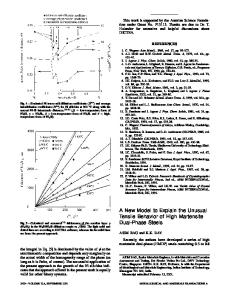Void formation during tensile testing of dual phase steels
- PDF / 3,978,891 Bytes
- 11 Pages / 613 x 788.28 pts Page_size
- 37 Downloads / 347 Views
I.
INTRODUCTION
DUALphase steels which consist of microstructures with primarily ferrite and martensite exhibit unique combinations of strength and ductility, 1-7 and thus have been considered for applications which require good formability. In sheet steels the maximum obtainable strain is a combination of uniform strain and nonuniform strain associated with necking. The uniform strain is limited by the onset of plastic instability. Plastic instability in turn depends on sample geometry, strength, and strain hardening behavior. 8 The strain in the neck is more complex and is controlled by strain hardening, strain rate sensitivity, and ductile rupture by the nucleation, growth, and coalescence of voids. The latter process is microstructure controlled through the distribution of void nucleation sites 9 and by the local stress state at the voids. For many applications, sheet metals are deformed beyond the uniform strain in order to utilize the additional strain which can be obtained beyond the point of plastic instability. In sheet metal forming operations at the point of instability, necking develops with geometries defined as either diffuse or diffuse plus localized neck. l~ A diffuse neck in thin sheets develops with significant contraction strains in both the width and thickness directions and is accompanied with extensive post-uniform deformation. If the sample is sufficiently wide, then after the formation of a diffuse neck, flow constraints within the neck limit further width strain. As a result, additional post-uniform deformation is accommodated by through thickness strains, and a condition referred to as a localized neck forms along a plane-strain direction. Furthermore, the development of a localized neck D.L. STEINBRUNNER, formerly Graduate Research Assistant, Colorado School of Mines, is Research Engineer, The Dow Chemical Company, Texas Operations, Freeport, TX 77541. D.K. MATLOCK, Charles E Fogarty Professor, and G. KRAUSS, AMAX Foundation Professor of Physical Metallurgy, are with the Department of Metallurgical Engineering, Colorado School of Mines, Golden, CO 80401. Manuscript submitted August 22, 1986. METALLURGICAL TRANSACTIONS A
due to through thickness thinning significantly limits the usable post-uniform strain. Tensile deformation studies of dual phase steels have considered both the strengthening mechanisms which control the strength and strain hardening behavior 1'3'5-7'13 and the mechanisms of ductile rupture. ~4-20Void nucleation in dual phase steels has been associated with either nonmetallic inclusions 16'2~ or with martensite particles. 3,534-J9,z~ Void nucleation at the martensite results from decohesion at the ferrite-martensite interface or brittle fracture of the martensite particles, and has been observed primarily within necked regions at high local strains. 3'5'1436However, limited observations ~9have shown that voids nucleate prior to necking at true plastic strains as low as 0.05. Void growth and coalescence has also been correlated with the high local strains associated with
Data Loading...











